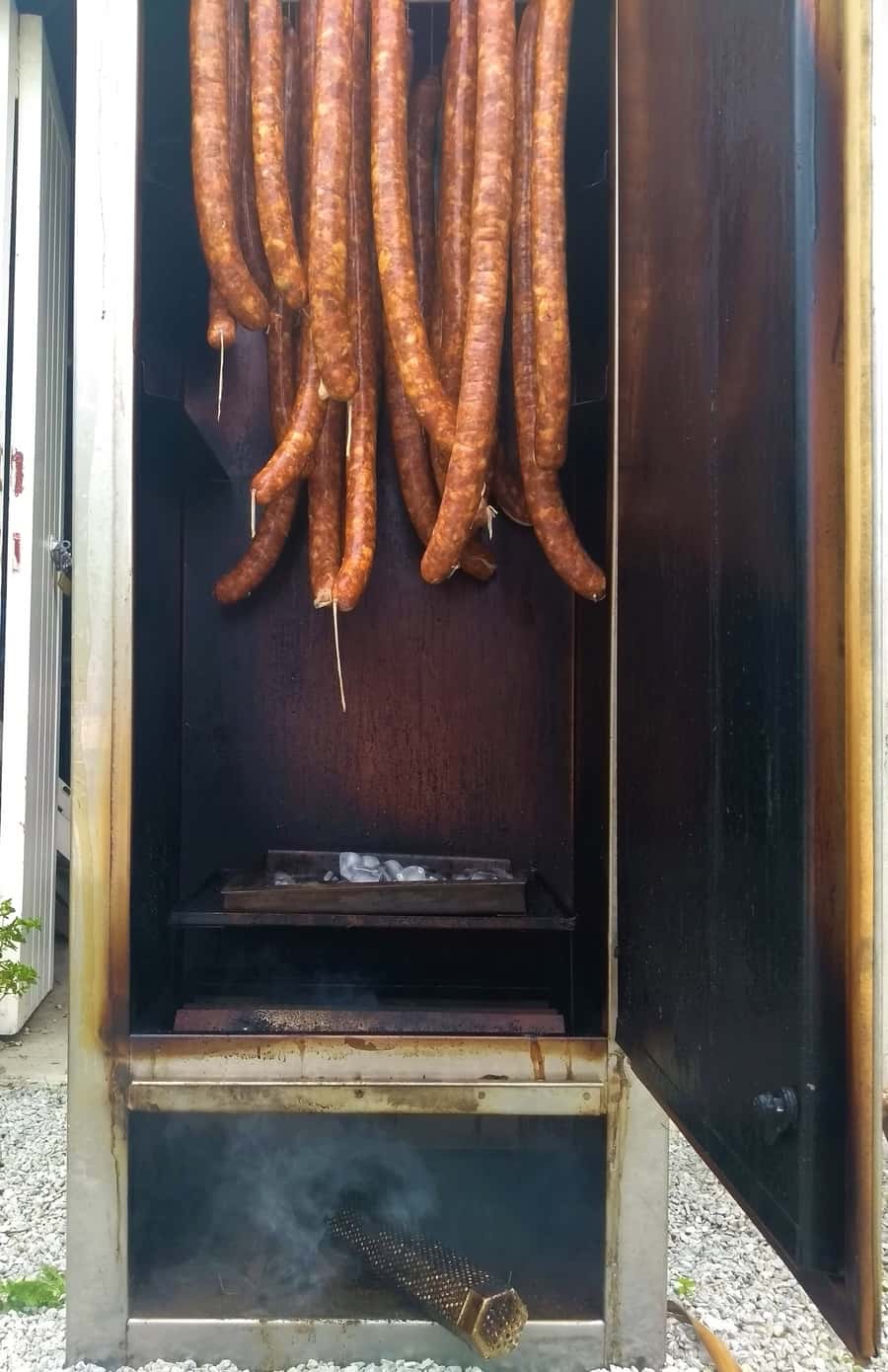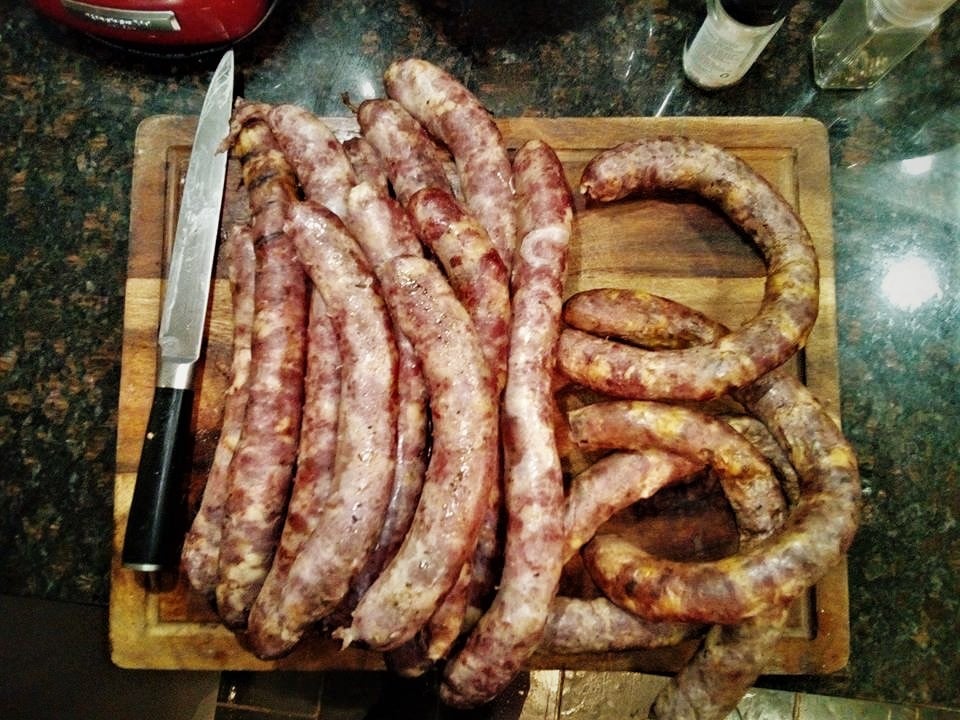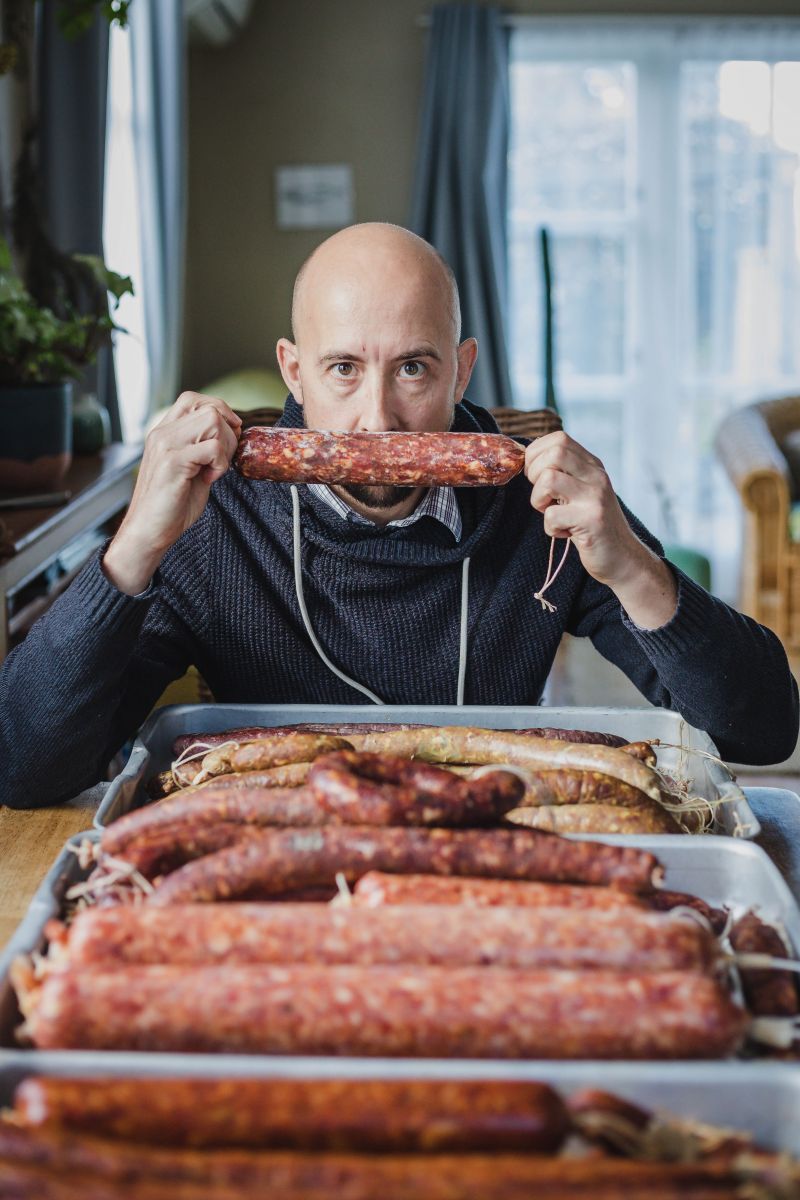Salami-making can be done with quite a few different types of kits.
For someone new to salami, a salami kit is a logical idea. However, not all salami kits are the same!
Here is a range of available salami-making kits, which I will make a few comments about below:
List of Salami-Making Kits
- Umai Dry Artisan Dry Sausage Kit
- Sausage Maker
- Hi Mountain’s Salami Sausage Kit
- Cabela’s Smokehouse Beer Salami Sausage Making Kit
Salami is a mysterious artisan craft, and I believe it’s not just a recipe but a process where you use salt, acidity, and sometimes cold smoke (for a specific type of salami style, more on this below).
It’s a craft, not a recipe. It takes some skills to develop to create a consistently delicious salami.
It falls into the advanced foodie charcuterie category. For my online courses here at Eat Cured Meat, I always say it’s better to start with whole-muscle charcuterie/salumi before fermented/dried salami making.

I’ll go over below what to expect from these kits and what you are getting yourself into.
Disclaimer* These are my thoughts on what is available and hopefully guide you toward your salami goals!
I don’t see myself as an expert. However, I’ve been helping people make dry-cured meat, cured salami, cold-smoked, hot-smoked, and emulsified sausages for a few decades.
I have a fair idea about the processes and will highlight these thoughts!
With all these salami kits provided, you add the meat.
Remembering, any sausage or salami is a ratio of 80/20 Meat to Fat
I go up to 65/35 for some rich, classic styles.
Good quality meat and pork back fat (pork fat is neutral and the ‘go to’ fat for sausage and salami).
Excellent meat handling hygiene and working at a just above freezing point temperature for the meat. It is critical to minimize unwanted bacteria.
You can buy pork butt or pork shoulder in big chunks from the butcher. This will have approximately 20% pork fat, in my experience. It often depends on the age of the pig; if the pig is killed under 12 months, there will be WAY less fat than an older pig.
So you may not need to source pork back fat for your salami-making kit.
Salami-Making Kits in Detail
Here is a breakdown of some kits for you.
Umai -Dry Artisan Dry Sausage Kit – 32 mm/1 1/4″
I think this is an excellent choice for someone starting (though you should have maybe done some meat curing of muscles beforehand, here is a guide I wrote about this). This kit has all the essentials, and you can use the 2-way breathable casings to dry your salami in your regular kitchen fridge.
One of the challenges with salami is drying the meat so it dries out on the inside evenly. If the outside dries out too fast, you get ‘case hardening’ which can lead to many issues. If the environments are too moist, you may grow too much fungal. – This kit deals with this issue.
Umai uses a membrane casing, which makes this airflow regulation for you, in your kitchen fridge.
This is the ‘real’ fermented and dry-cured salami – dry-cured slowly for maximum flavor!
Quick fermentation explanation.
Starter Culture is added after salt/spices – the starter culture eats the simple sugar, producing lactic acid. The ‘acidity’ (lower pH) protects the salami during drying. Unwanted bacteria do not like acidic environments; it adds a tangy salami flavor!
I suggest the 32mm since you will get a finished delicious salami in 4-6 weeks; they also have a 50mm selection of salami or even 70mm.
Sausage Maker Hard Salami Sausage Kit
Make 25 lbs.
These kits seem dry-cured salami kits but aren’t fermented, maybe? There is no mention of this in the description. As I said, I haven’t used it, but I am looking at it from an experienced producer of salami who studies this stuff for a living! Fermenting/Acidifying the salami is another layer of protection.
Also, some comments have been made that you will need the temperature that assists drying – 50-60F or 10-15C. This is where you select or create an environment where you can hang dry-cured meat for drying, also ideally humidity is 75-85% (here is a post I wrote about DIY curing chambers).
Salami Maker is an online website store with a lot of decent gear related to curing and smoking meat. These guys understand what they are talking about.
Hi Mountain’s Salami Sausage Kit
Not entirely accurate pictures on this box…
Technically, it is a salami, just not a dry-cured salami, which it shows.
It shows a picture of dry-cured salami on the box; however, this is a cooked, hot-smoked salami kit.
So you can use a smoker to cook/smoke it until the internal temperature is reached.
It’s not quite a classic salami; it’s more like a sausage cooked in a hot smoker = hot smoked salami.
I’ve done hot smoked salamis and have been happy with the results, but it’s more a sausage that is cooked/smoked.

I downloaded the instructions and cut a bit out to highlight this is a cooked salami, not dry-cured salami:

Cabela’s Smokehouse Beer Salami Sausage Making Kit
Make 25lbs, not dry cured salami as per the above Hi Mountain kit, this is is a cooked/smoked sausage salami.
And again, it’s misleading because the picture on the front is a dry-cured salami.
Of the ingredients on the package, I am not sure what they are for; I would presume these are commercial-type ingredients for texture/preservation or sweetness, i.e., sodium erythorbate (looks to be a Vitamin C alternative)
Salami is a Process and Craft Not Just a Recipe
For dry-cured salami (here are an article on pH meter salami testing), it takes an understanding of the curing, potential pH/acidity, fermentation, good/baharmfulolds
Umai would be the salami kit for someone who wants their handheld but still creates a decent standard product.
Being a traditional purist, I would say the outcome still doesn’t quite reach a hung, dry-cured salami. Because of what I have learned, dry-cured flavors develop over time.
There is a reason the 12-24 month + whole muscle or dry-cured salami is considered unique (also some science around how the amino acids in the proteins break down over time). Ie. Parma Ham or Well-Aged Classic Iberian Jamon
In an Umai salami, you are drying it out to get to a specific weight loss. However, it’s down rapidly in just above freezing temperature in your fridge.
But for a starter salami kit, it’s all good (apart from the single-use plastic membrane casing). The natural casing is my preference, but following the more complicated traditional artisanal journey, for an Umai Kit to work, it has to use their Membrane Casing.
Contents of a Salami Kit
Salt
Sea Salt is the main curing ingredient; it inhibits water activity, making it an in-hospital environment for unwanted bacteria.
Spices
May vary, black pepper will be very standard for most kits.
Casings
They won’t be natural since intestine casings must ideally be in salt and a fridge. They are often seen as the best salami casing, though.
Fibrous or Cellulose Protein Casing is often used; these are strong and have an absorbent ability.
Pink Curing Salt No. 2 or No. 1
To Protect the meat from botulism, meager amounts are used.
These Nitrates/Nitrites are often in many vegetables we consume and produce in our bodies.
Fermentation Starter Culture
Adding to ‘acidify’/ fermented dry-cured salami, to give it another layer of protection, often dextrose or another simple sugar is added to feed this starter culture after stuffing and before drying (fermentation stage). Although the starter culture also consumes the existing sugars inside the meat, the dextrose addition is used as an ‘added’ safety measure. That’s not how the Italian traditionalists do it, though! More a commercial/domestic insurance policy.
This applies only to the dry-cured fermented salami kit.
Issues with pH and Salami Making Kits
pH meters that work are another significant investment that involves a charcuterie or commercial producer. It’s not essential, but it does give you confidence in the production of salami in a precise way (here are some mistakes I’ve learned from).
This is all about the acidic protection, I use start mold cultures for my dry-cured salami – but haven’t yet trailed out a bunch of ph meters they cost a lot!
Don’t bother using litmus paper; it’s not accurate enough.
I hope these thoughts helped a bit – salut!


Tom Mueller
For decades, immersed in studying, working, learning, and teaching the craft of meat curing, sharing the passion and showcasing the world of charcuterie and smoked meat. Read More
